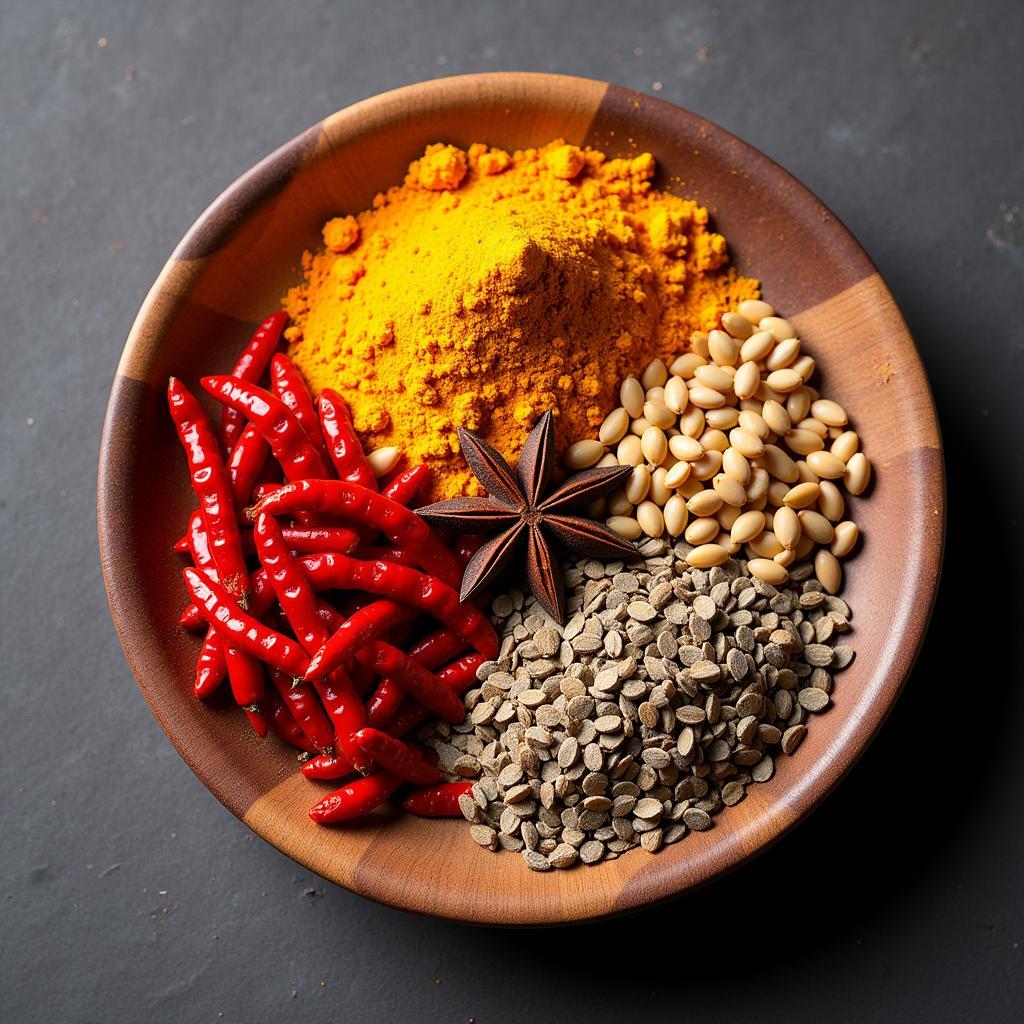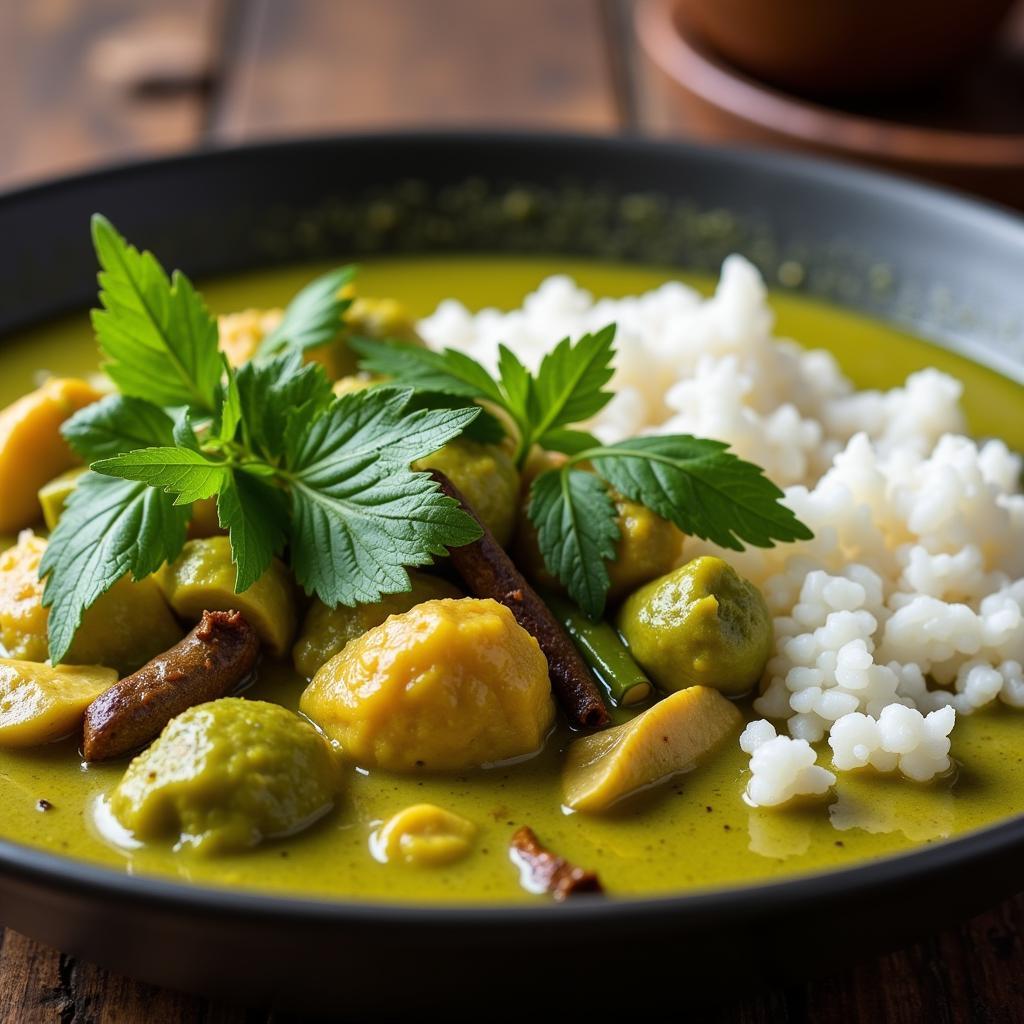Thai cuisine is celebrated worldwide for its vibrant flavors and intoxicating aromas. This symphony of taste is orchestrated not just by fresh ingredients, but also by a masterful blend of Common Spices In Thai Food. These spices don’t just add depth and complexity to dishes, they tell stories of ancient traditions, cultural influences, and the art of balancing sweet, sour, salty, spicy, and bitter elements in perfect harmony.
 Colorful Array of Common Spices in Thai Food
Colorful Array of Common Spices in Thai Food
Unveiling the Spice Stars of Thai Cooking
Let’s embark on a flavorful journey to uncover the common spices in Thai food that contribute to their unique character:
1. Chili Peppers: Igniting the Heat
No exploration of Thai spices would be complete without mentioning chilies. From the fiery bird’s eye chili to the milder Thai chili, these potent pods infuse dishes with varying levels of heat. They form the backbone of many iconic Thai pastes, like red curry paste, and add a fiery kick to stir-fries and soups.
2. Galangal: The Citrusy Cousin of Ginger
Often confused with ginger, galangal brings a distinct citrusy and earthy flavor to Thai cooking. This rhizome shines in soups like Tom Kha Gai, lending a warm, peppery depth that complements the coconut milk beautifully.
3. Lemongrass: A Refreshing Citrus Symphony
As its name suggests, lemongrass infuses dishes with a refreshing, citrusy aroma and taste. Whether bruised and added whole to curries or finely sliced into salads, lemongrass adds a vibrant, aromatic dimension that balances richer flavors.
4. Kaffir Lime Leaves: A Unique Aromatic Depth
These glossy, double-lobed leaves possess an intense citrus fragrance that is unlike any other. Kaffir lime leaves are often added whole to curries and soups, imparting their unique flavor as they simmer. They are also used to infuse coconut milk, creating a base for fragrant Thai desserts.
5. Coriander Root: The Earthy Foundation
While coriander seeds and leaves are widely used, Thai cuisine also highlights the earthy depth of coriander root. This ingredient forms a crucial part of curry pastes, adding a subtle, earthy sweetness that balances the heat of chilies.
Beyond the Basics: Exploring Other Common Spices in Thai Food
While the spices above take center stage, several other players contribute to the complex tapestry of Thai flavors:
- Turmeric: Known for its vibrant yellow hue and earthy aroma, turmeric lends warmth and a slightly bitter edge to curries and stir-fries.
- Cumin: This spice adds a warm, earthy depth to certain Thai curries, particularly those with Indian influences.
- Peppercorns: From pungent black peppercorns to fragrant white peppercorns, these tiny powerhouses add varying levels of heat and complexity.
Balancing Flavors: The Art of Thai Spice Blends
Thai cuisine isn’t just about individual spices; it’s about the art of combining them into harmonious blends. Curry pastes, a cornerstone of Thai cooking, exemplify this perfectly. These pastes, often made with a mortar and pestle, combine fresh herbs, spices, and aromatics, creating a symphony of flavors that form the base of many iconic dishes.
 Aromatic Thai Green Curry with Steamed Rice
Aromatic Thai Green Curry with Steamed Rice
The Allure of Thai Food: More Than Just Spices
While common spices in Thai food play a crucial role in shaping its distinctive flavors, it’s important to remember that the magic lies in the balance. The interplay of sweet, sour, salty, spicy, and bitter elements, the use of fresh herbs and ingredients, and the masterful techniques passed down through generations all contribute to the extraordinary culinary experience that is Thai food.
FAQs: Unraveling the Mysteries of Thai Spices
-
What makes Thai food so spicy? The use of fresh and dried chilies, particularly bird’s eye chilies, contributes significantly to the heat in many Thai dishes.
-
Can I substitute Thai spices with other ingredients? While some substitutions are possible, using authentic Thai spices will yield the most accurate and flavorful results.
-
Where can I find Thai spices? Asian grocery stores and online retailers are excellent sources for sourcing a wide variety of Thai spices.
Interested in learning more about the diverse world of flavors? Discover the similarities and differences between Thai and Chinese cuisine in our article: is thai food like chinese food. For unique gift ideas for the food enthusiast in your life, explore our curated collection of indian food gifts.
Need Help Navigating the World of Flavors?
At Mina Cones Food, we’re passionate about exploring the diverse world of culinary delights. Whether you’re seeking more information on common spices in Thai food, need help finding the perfect soy free restaurant food, or are curious about festive dishes for special occasions like the ides of march food, our team is here to assist you. Contact us at Phone Number: 02437655121, Email: minacones@gmail.com, or visit us at 3PGH+8R9, ĐT70A, thôn Trung, Bắc Từ Liêm, Hà Nội, Việt Nam. Our dedicated customer support team is available 24/7 to answer your questions and guide you on your culinary journey.